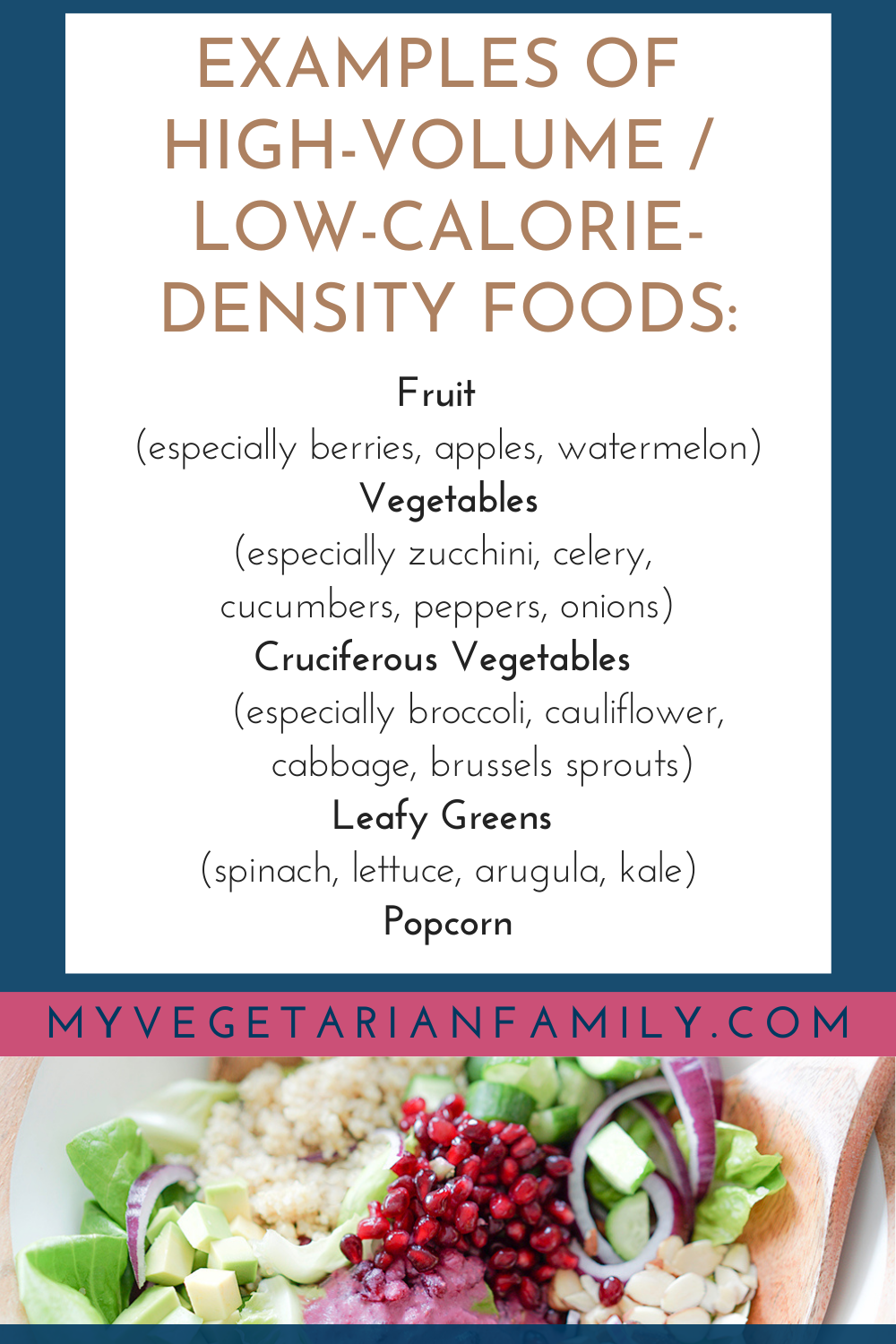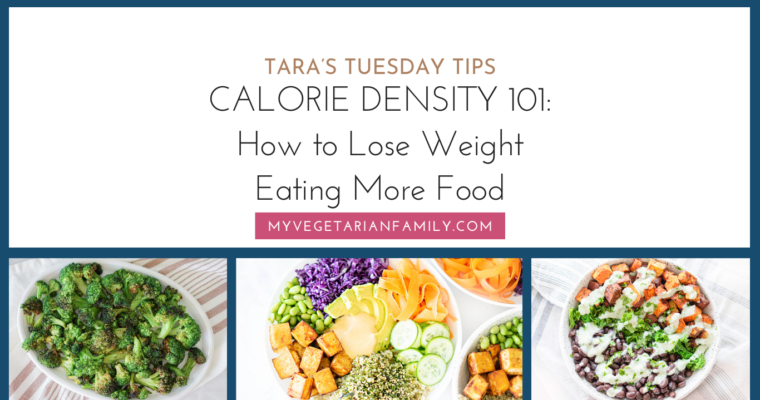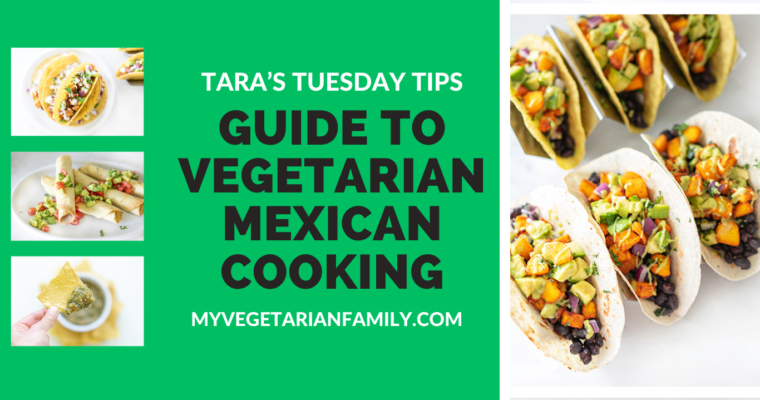Are you curious about volume eating? Not sure if it is right for you? Can you use volume eating for better health? Longevity? Improved blood sugars and gut health? How is it different for vegetarians? SO MANY questions!
Tara’s Tuesday Tips:
The Vegetarian’s Guide to Volume Eating
If you have stopped by my little piece of the internet before, you know I am not a fan of diets, diet culture, fad diets, or food trackers. What I am a fan of is finding an eating style that supports your long-term health and nutrition goals. If you are looking for a way of eating that frees you of calorie counting, restriction, and feeling hungry, this guide might be for you, vegetarian or not! Let’s get to it!
What Exactly is Volume Eating?
Allow me to introduce you to one of my favorite terms: low-calorie-density foods, not low-calorie foods, calorie density. Volume eating is based on eating more foods that are less calorie dense. Essentially, you eat more volume of food while consuming less calories overall.
Low calorie / high volume. This gives you the physical sensation of feeling full, the feeling that you have eaten more. In actuality, yes, you have eaten more but taken in less calories. These foods also have a tendency to have more fiber, water and nutrients. They make you feel full! They also keep your blood sugars more stable + give you the much needed fiber for better gut health.
What is Calorie Density?
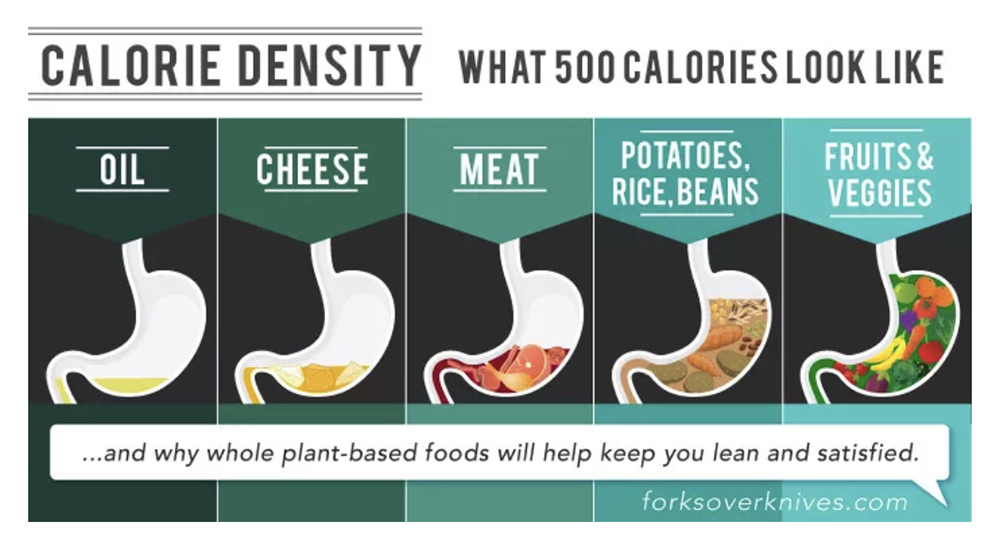
You must understand calorie density to understand volume eating. Calorie density = number of calories in a given amount/weight of food.
Increased calorie density = more calories for less food.
Decreased calorie density = more food for less calories.
For example, If I eat 2 cups of raw broccoli, I will be full. If I eat 2 cups of potato chips, maybe not. I could keep eating cups full of broccoli if I were still hungry and still not get to the calorie count in those chips. What do I get in those 2 cups of broccoli? More fiber, water, nutrients, and yep, you guessed it I feel full while overall consuming less calories.
The chart below gives you an idea of the types of foods that will be more calorie dense per pound (extracted from How Not To Diet).
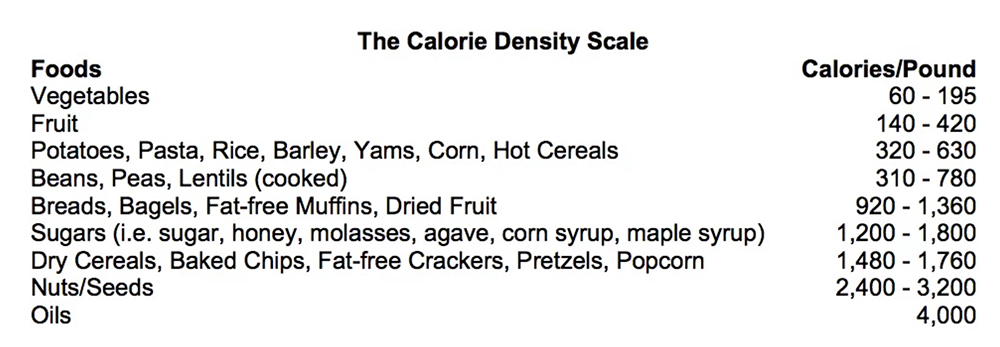
How Does Volume Eating Work?
Volume eating helps you feel full longer, helps you make more mindful food choices, and if your goal is to lose weight, you will definitely do that if you prioritize low-calorie-dense foods. All of these benefits without feeling hungry or restricted.
The strategy is simple: prioritize high-volume foods. In the world of yo-yo dieting, the quest for a thin body, and now ever-growing popularity of weight loss medications, we need a solution that can fit into our everyday lives and we can stick with forever. This is it. Eat foods that satisfy you and make you feel full. Eat lots of them. Check out this visual from nutrition facts.org:
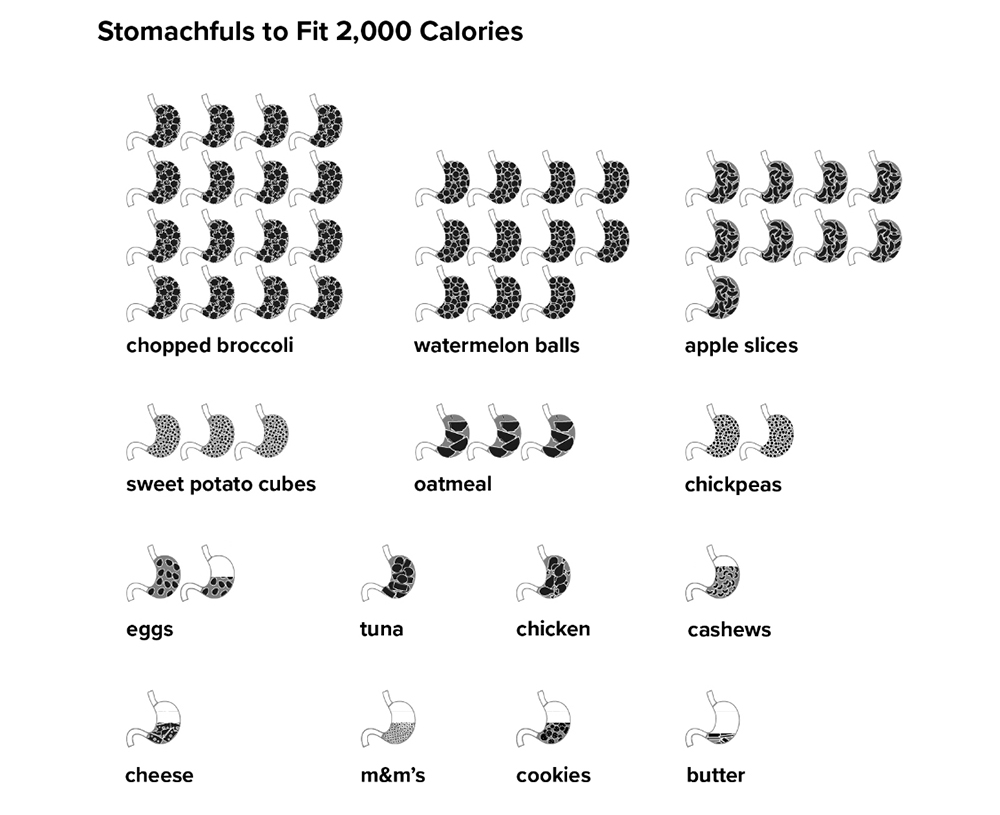
Is Volume Eating Right for Everyone?
No, if you have a history of disordered eating behaviors, orthorexia, issues with bowel motility, or are an endurance athlete.
Yes, this can be a helpful tool if you are looking improve your weight, BMI, blood sugars, appetite, constipation, digestion, or increase satiety without increasing caloric intake. Vegetarians, plant-based eaters, vegans, this is a perfect option for you if you pay attention to still getting enough protein + healthy fats.
The wonderful thing about volume eating, vegetarian or not, is that you learn to add foods instead of subtracting. It takes away the feeling of being restricted, counting calories, and always feeling hungry.
Why Should You Pay Attention to Volume?
We like to feel full and satisfied when we eat, that is instinctively human behavior. So much so that there is rising popularity of medications that do that very thing, and in turn someone on that medication is supposed to feel full, eat less, and lose weight. One of the key signals that the brain looks for to tell you to stop eating is your stomach stretching. The volume of food you take in causes your stomach to stretch and tell your brain you are full. When you prioritize high volume, low-calorie-dense foods, you eat slower and you get fuller faster, allowing your body time to signal the brain that you have had enough, and you don’t eat beyond what you need. Magic!
The Vegetarian’s Starter Guide to Volume Eating: A few tips …
- Start each meal with a salad, cut up veggies, soup, or fruit. Multiple nutritional research studies tell us that this has been proven to work. Remember, your stomach can only hold so much, so fill it up with the high water and fiber content foods first + leave less room for the high-calorie-density foods.
- Don’t drink your calories. Liquids (think juice or sodas) are not satisfying. The whole, solid food that you must chew fills your stomach more leading you to consume fewer overall calories.
- Add vegetables and/or fruit to EVERY meal. Yes, even breakfast. This always helps with lowering the calorie density + gives you the extra fiber to feel full.
- Oils and butter bring up the calorie density a lot. Remember one tablespoon of oil can equal the same calories as up to 2 cups of berries.
- If you want to eat high-calorie-density foods, incorporate them into low-calorie-density meals. For example, add nuts to your oatmeal, avocado or dried fruit into your salad.
- Remember: low-calorie-density foods are typically whole, unrefined, unprocessed foods with high water content and high fiber content. Eat them first + eat more of them! Color + fiber are your BFF’s with volume eating.
- Read these:
Examples of High-Volume / Low-Calorie-Density Foods
Fruit
(especially berries, apples, watermelon)
Vegetables
(especially zucchini, celery, cucumbers, peppers, onions)
Cruciferous Vegetables
(especially broccoli, cauliflower, cabbage, brussels sprouts)
Leafy Greens
(spinach, lettuce, arugula, kale)
Popcorn
Food for Thought
Switching your mindset to calculating calorie density is easy and just takes a little practice. Who doesn’t want to improve chronic disease, weight, constipation, and appetite by eating more food?!?!?! What makes it even easier? Eating a whole food, plant-based diet. Ha, this is a vegetarian food blog after all, you knew I would bring it back around at some point, didn’t you? On a serious note, prioritize colorful, fiber-filled foods, eat them first, and eat lots of them. Try it and see! As always, talk to your healthcare provider first before making any changes.
Enjoy good food in the company of good people + come back every Tuesday for your weekly dose of Tara’s tips 🍏
All the best,
Tara 💚
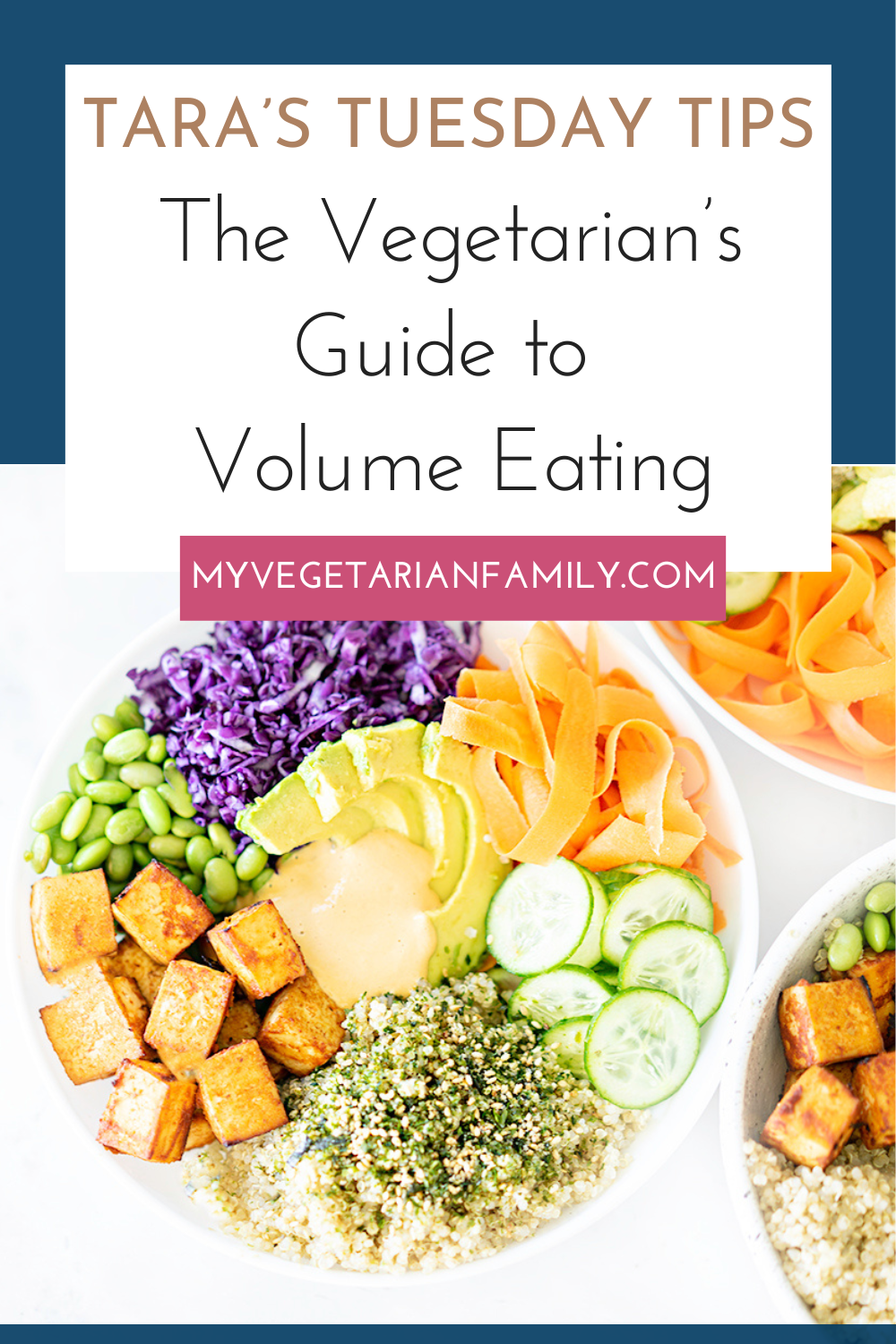
⭐Did you leave The Vegetarian’s Guide to Volume Eating? Leave a comment below!
📸I love to see your creations! Follow me on Instagram @myvegetarianfamily and hashtag it #myvegetarianfamily
📩Be sure to subscribe here to my weekly emails for tips + recipes so that you never miss a veggie thing!

